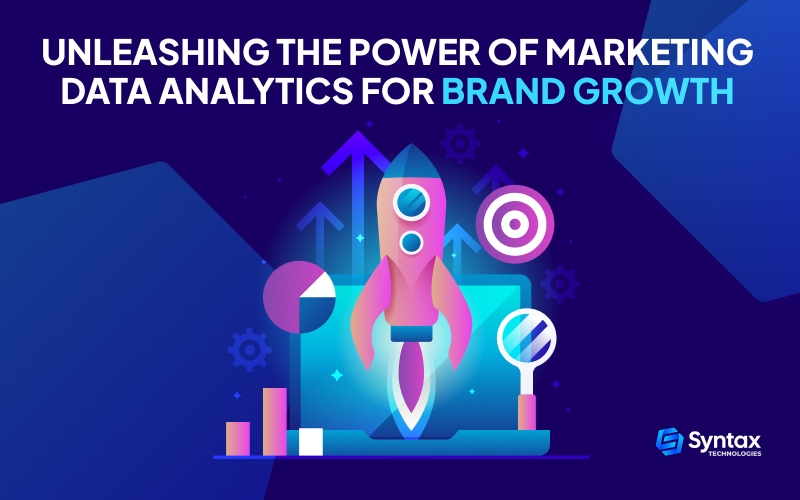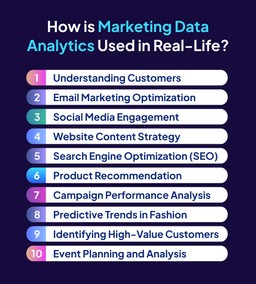Welcome, Future Data Pioneers!
If you’re here, you’re not just curious; you’re on the cusp of mastering the dynamic realm where data meets marketing magic.
Together, we’ll unravel the mysteries, harness the power of analytics, and —transform raw numbers into something that resonates with a brand’s narrative.
If you’re a newcomer, it’s best to take a data analytics course to freshen up your knowledge about the core elements of the data world before getting into the nitty gritty of marketing data analytics.
Now get ready to be inspired because the world of marketing data analytics is about to reveal its secrets to you!
What are the Key Features of Marketing Data Analytics?
Data Discovery
- Exploring: Gathering info from different places like websites, social media, and customer chats.
- Why It’s Cool: It’s like uncovering hidden treasures about what our audience is up to!
Mixing and Mingling Data
- Blending: Combining all our data buddies into one big, happy group.
- Why It’s Cool: Now our data pals can chat and share stories, making our insights even more interesting!
Data Cleanup Party
- Cleaning Up: Fixing any typos or missing info in our data so it’s all spick and span.
- Why It’s Cool: It’s like giving our data a makeover – everyone loves a good glow-up!
Storytime with Data
- Storytelling: Summing up and chatting about what happened in the past with our data pals.
- Why It’s Cool: Imagine it’s a storybook, but with data! What happened, who did what – it’s all there!
Detective Work with Data
- Investigating: Finding out why things happened and what made them tick.
- Why It’s Cool: We get to play detective, figuring out the secret sauce behind our successes (or oopsies)!
Future Fortune-Telling with Data
- Predicting: Using our magical data ball to predict what might happen next.
- Why It’s Cool: It’s like peeking into the future – who doesn’t want to be a data fortune-teller?
Data Magic Recommendations
- Magic Tricks: Recommending cool tricks and moves based on what we’ve learned.
- Why It’s Cool: It’s like having a wise data wizard telling us the best spells to cast for success!
Party with Different Data Cliques
- Hangin’ with Friends: Grouping our customers based on what makes them unique.
- Why It’s Cool: Tailoring our messages like we’re sending a cool party invite – everyone’s on the VIP list!
Money Talks with Data
- Cash Check: Checking out if our efforts are making us the big bucks.
- Why It’s Cool: It’s like counting our pocket money but with a whole bunch of zeros!
Data Art Show
- Art Time: Showing off our data in cool pictures and graphs.
- Why It’s Cool: Imagine it’s an artsy exhibition, but it’s all our favorite data colors instead of paint!
Live Updates with Data
- Real-Time Fun: Keeping an eye on data happenings as they unfold.
- Why It’s Cool: It’s like having a backstage pass to the coolest show in town – no spoilers, just real-time thrills!
Smart Tech and Data BFFs
- Tech Buddies: Bringing in smart tech pals to make our data chats even cooler.
- Why It’s Cool: It’s like having a bunch of superhero sidekicks – they make everything more awesome!
So, grab your data sunglasses because this journey is all about cool insights, awesome discoveries, and turning our data world into a place where everyone wants a front-row seat.
How is Marketing Data Analytics Used in Real-Life?
Let’s dive into some real-life situations where marketing data analytics is like your friendly sidekick, making things awesome:
Understanding Customers
- Scene: Using analytics in an online store to identify customer preferences and behaviors.
- Result: Enhanced shopping experience through personalized recommendations and targeted promotions.
Email Marketing Optimization
- Scene: Applying analytics to determine the best timing and content for email campaigns.
- Result: Improved email open rates and click-throughs, leading to more effective email marketing.
Social Media Engagement
- Scene: Utilizing analytics to track the performance of social media posts.
- Result: Increased engagement on social media platforms due to more effective content.
Website Content Strategy
- Scene: Using analytics to understand which parts of a website attract and engage visitors.
- Result: Better content strategy leading to a more engaging website and increased visitor traffic.
Search Engine Optimization (SEO)
- Scene: Employing analytics to enhance a website’s SEO strategy.
- Result: Higher search engine rankings and increased website visibility.
Product Recommendation
- Scene: Leveraging analytics in e-commerce to recommend products to customers.
- Result: Improved customer experience and increased sales through personalized product suggestions.
Campaign Performance Analysis
- Scene: Analyzing marketing campaign data to gauge effectiveness.
- Result: More successful marketing campaigns due to insights gained from analytics.
Predictive Trends in Fashion
- Scene: Using predictive analytics to foresee fashion trends.
- Result: The brand becomes a trendsetter, anticipating and leading market trends.
Identifying High-Value Customers
- Scene: Using analytics in a subscription service to identify key customers.
- Result: Enhanced customer relationships and loyalty through tailored services for high-value customers.
Event Planning and Analysis
- Scene: Analyzing data from events to understand attendee preferences.
- Result: More engaging and successful events, leading to a better overall attendee experience.
Is College
Worth It Anymore?
What Are Some Important Marketing Data Analytics Tools?
Of course, the marketing magic would only come to life with some data tools!
Here are five crucial marketing data analytics tools:
- Purpose: Comprehensive web analytics tool for tracking website traffic, user behavior, and conversions.
- Key Features: Traffic sources, user demographics, behavior flow, and goal tracking.
- Purpose: All-in-one marketing toolkit providing insights into SEO, PPC, social media, content, and competitor analysis.
- Key Features: Keyword research, site audit, backlink analysis, and position tracking.
- Purpose: Offers heatmaps, session recordings, and surveys to understand user behavior and improve website usability.
- Key Features: Heatmaps, session recordings, feedback surveys, and funnel analysis.
- Purpose: SEO software offering tools for keyword research, link building, and site audits.
- Key Features: Keyword explorer, link explorer, on-page optimization, and site crawl.
- Purpose: An open-source IDE for the R programming language, widely used for statistical computing and data visualization.
- Key Features: Data manipulation, statistical modeling, and visualization.
- Purpose: Customer analytics tool emphasizing customer journey tracking and conversion optimization.
- Key Features: Funnel analysis, cohort reports, and customer behavior tracking.
- Purpose: AI-powered analytics tool for data discovery, visualization, and predictive analysis.
- Key Features: Natural language processing, predictive analytics, and automated data preparation.
- Purpose: Focuses on visual analytics with features like heatmaps, scrollmaps, and user recordings.
- Key Features: Heatmaps, scrollmaps, user recordings, and A/B testing.
- Purpose: Data visualization tool that transforms raw data into interactive, shareable dashboards.
- Key Features: Drag-and-drop interface, real-time analytics, and diverse data connectors.
- Purpose: Specializes in product analytics, focusing on user engagement, retention, and event tracking.
- Key Features: Funnel analysis, A/B testing, and user segmentation.
- Purpose: Part of the Adobe Marketing Cloud, offering analytics for digital marketing and customer intelligence.
- Key Features: Real-time analytics, segmentation, and multi-channel attribution.
- Purpose: Embedded analytics tool within the Salesforce platform, providing insights into sales, customer service, and marketing.
- Key Features: Dashboards, data exploration, and AI-driven analytics.
How to Get Started with Marketing Data Analytics
Getting started with marketing data analytics involves a step-by-step approach to ensure you leverage insights effectively.
Here’s a guide to help you embark on your journey:
- Define Your Objectives
Why Start Here: Clearly outline your marketing objectives and what you want to achieve with data analytics. Whether it’s improving campaign performance, understanding customer behavior, or optimizing website traffic, defining goals sets the foundation.
- Identify Key Metrics
Why Start Here: Choose key performance indicators (KPIs) aligned with your objectives. These could include website traffic, conversion rates, customer acquisition costs, or social media engagement.
- Select Relevant Tools
Why Start Here: Based on your objectives and KPIs, choose analytics tools that suit your needs. For starters, Google Analytics is a robust and user-friendly choice for website analytics.
- Implement Tracking
Why Start Here: Set up tracking mechanisms to gather data. This may involve adding tracking codes to your website, configuring event tracking, or integrating analytics tools with other platforms.
- Clean and Organize Data
Why Start Here: Ensure data accuracy by cleaning and organizing it. Remove duplicates, correct errors, and structure data in a way that facilitates analysis.
- Learn Basic Analytics Concepts
Why Start Here: Familiarize yourself with basic analytics concepts such as dimensions, metrics, segments, and funnels. Understanding these fundamentals is crucial for effective analysis.
- Explore Data Visualization
Why Start Here: Use tools like Tableau, Google Data Studio, or even Excel to visualize data. Visualization enhances your ability to interpret and communicate insights effectively.
- Conduct Initial Analysis
Why Start Here: Begin with simple analyses. Examine trends, identify correlations, and draw insights from your data. This helps in gaining a foundational understanding of your marketing performance.
- Attend Training and Workshops
Why Start Here: Enroll in marketing data analytics courses, attend workshops, or participate in online training programs. These resources provide structured learning and hands-on experience with analytics tools.
- Join Online Communities
Why Start Here: Engage with online communities, forums, and social media groups dedicated to data analytics. Connect with experts, seek advice, and learn from the experiences of others in the field.
- Apply Insights to Strategy
Why Start Here: Translate your findings into actionable strategies. Use data to refine marketing campaigns, improve user experience, and make informed decisions that align with your business goals.
- Iterate and Optimize
Why Start Here: Data analytics is an ongoing process. Continuously analyze, iterate, and optimize your strategies based on new insights. Regularly revisit your objectives and KPIs to ensure alignment with business goals.
Remember, the key to success in marketing data analytics is a combination of learning, practice, and a curious mindset.
Embrace the journey of discovery, and with each analysis, you’ll enhance your ability to drive meaningful results through data-driven marketing strategies.
Career Transition Toolkit
Mastering Marketing Data Analytics with Syntax’s Comprehensive Course
Having the power to analyze data is paramount for informed decision-making and business growth.
With tools like Google Analytics, SEMrush, Hotjar, Tableau, and Mixpanel, businesses gain valuable insights into customer behavior, optimize strategies, and achieve marketing excellence.
To further empower your journey into data analytics, consider exploring comprehensive courses. Syntax, a trusted education platform, offers a robust Data Analytics course.
By enrolling, you gain hands-on experience, deepen your understanding of analytics tools, and acquire practical skills to navigate the evolving data-driven landscape.
Strengthen your knowledge, unlock new possibilities, and embark on a path to becoming a proficient data analyst with Syntax’s expert-led courses.



